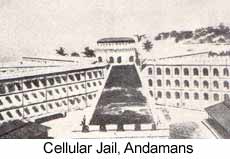

 |  |
 The Kakori case was a major setback to the revolutionaries of northern India, but it was not a fatal blow. Younger men such as Bejoy Kumar Sinha, Shiv Varma and Jaidev Kapur in U.P., Bhagat Singh, Bhagwati Charan Vohra and Sukhdev in Punjab set out to reorganize the HRA under the overall leadership of Chandrashekhar Azad. Finally nearly all the major young revolutionaries of northern India met a Ferozeshah Kotla Ground at Delhi on 9 and 10 September 1928, created a new collective leadership adopted socialism as their official goal and changed the name of the party to the Hindustan Socialist Republican Association (Army).
The Kakori case was a major setback to the revolutionaries of northern India, but it was not a fatal blow. Younger men such as Bejoy Kumar Sinha, Shiv Varma and Jaidev Kapur in U.P., Bhagat Singh, Bhagwati Charan Vohra and Sukhdev in Punjab set out to reorganize the HRA under the overall leadership of Chandrashekhar Azad. Finally nearly all the major young revolutionaries of northern India met a Ferozeshah Kotla Ground at Delhi on 9 and 10 September 1928, created a new collective leadership adopted socialism as their official goal and changed the name of the party to the Hindustan Socialist Republican Association (Army).Even though the HSRA and its leadership was rapidly moving from individual heroic actions towards mass politics, Lala Lajpat Rai's death, as the result of a brutal lathi-charge when he was leading an anti-Simon Commission demonstration at Lahore on 30 October 1928, led them once again to take to individual assassination. The death of this great Punjabi leader, popularly known as Sher-e-Punjab, was seen by the romantic youthful leadership of the HSRA as a direct challenge. And so, on 17 December 1928, Bhagat Singh, Azad and Rajguru assassinated, at Lahore, Saunders, a police official involved in deadly lathi-charge on Lala Lajpat Rai. In a poster, put up by the HSRA after the assassination, the assassination was justified as follows: 'The murder of a leader respected by millions of people at the unworthy hands of an ordinary police official . . . was an insult to the nation, It was, the bounden duty of young men of India to efface it . . We regret to have had to kill a person but he was part and parcel of that inhuman and unjust order that has to be destroyed.' The HSRA leadership now decided to let the people know about their changed objectives and the need for a revolution by the masses. Bhagat Singh and B.K. Dutt were asked to throw a bomb in the Central Legislative Assembly on 8 April 1929 against the passage of the Public Safety Bill and the Trade Disputes Bill which would reduce the civil liberties of citizens. The aim was not to kill, for the bombs were relatively harmless but, as the leaflet they threw into the Assembly hall proclaimed 'to make the deaf hear'. The objective was to get arrested and to use trial court as a forum for propaganda so that people would become familiar with their movement and ideology. Bhagat Singh and B.K. Dutt were tried in the Assembly Bomb Case. next page >> |
Copyright ©2000 indiansaga.info. All rights reserved.
By using this service, you accept that you won't copy or use the data given in this website for any commercial purpose.
The material on indiansaga.info is for informational & educational purpose only.
This site is best viewed at 800 X 600 picture resolution.